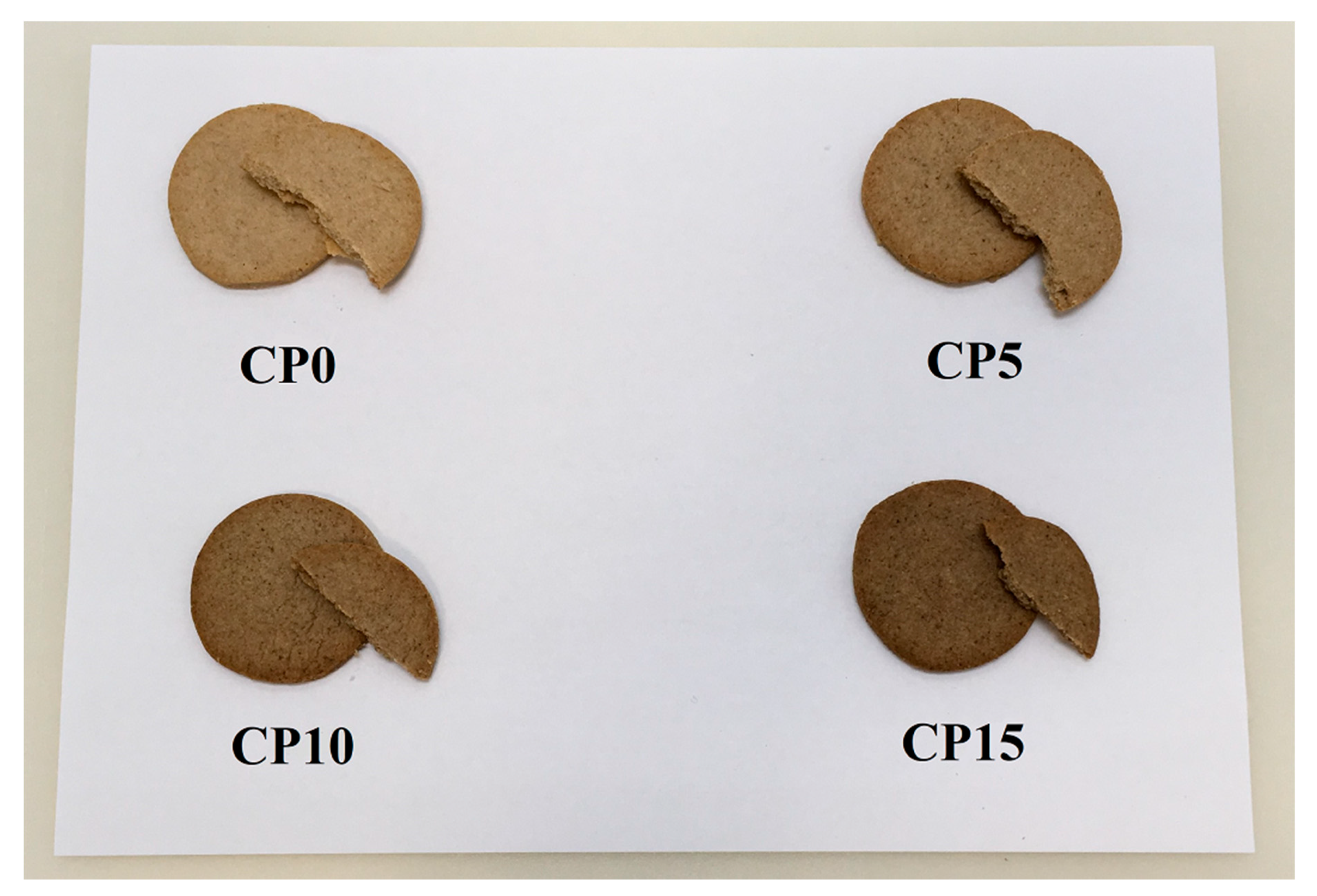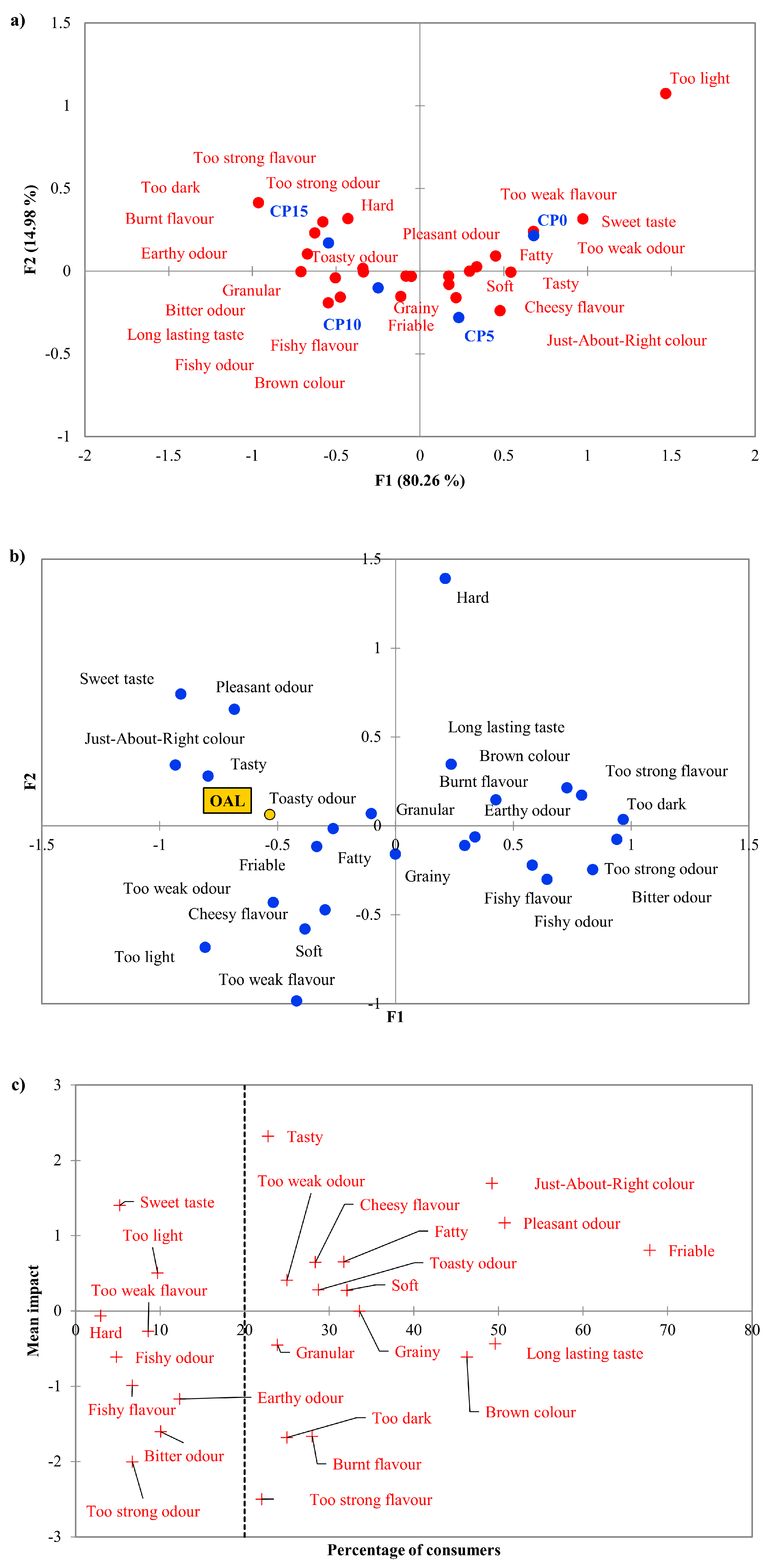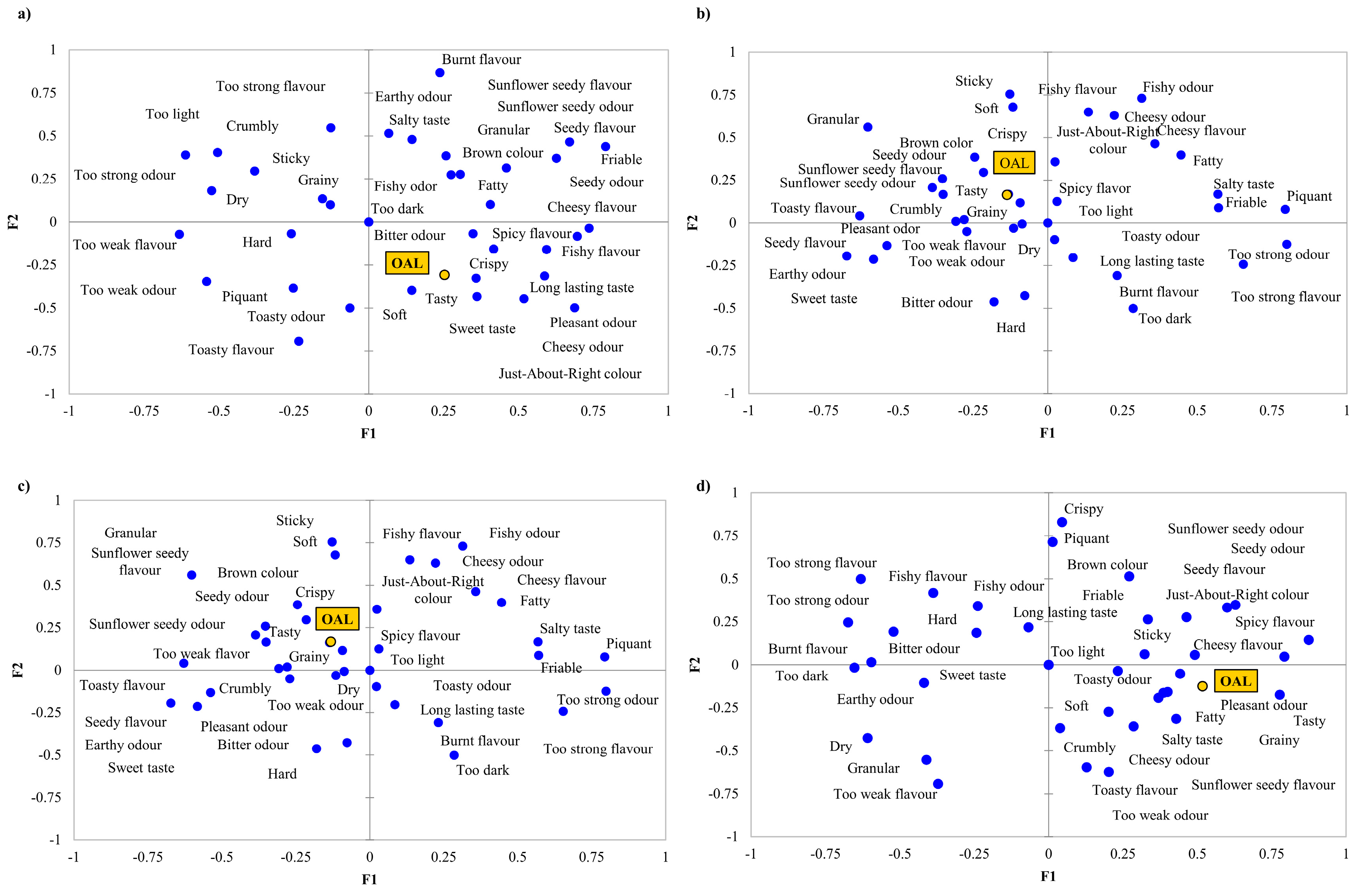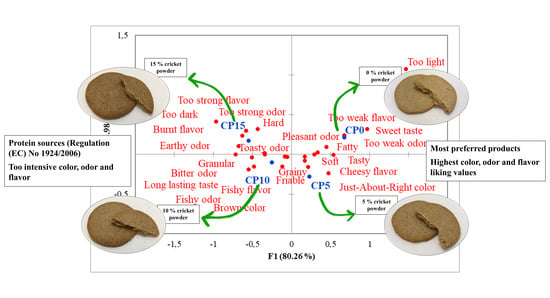Cricket-Enriched Oat Biscuit: Technological Analysis and Sensory Evaluation
Abstract
1. Introduction
- present the usability of different amounts of insect powder in a biscuit product,
- examine the technological effect of insect enrichment on the finished products, and
- discover how the insect content of the products affects the overall liking (OAL), and which attributes are the drivers of liking.
2. Materials and Methods
2.1. Materials
2.2. Methods
2.2.1. Estimated Nutritional Value
2.2.2. Technological Parameters and Quality Measurements
Colour Measurements
Textural Hardness
Total Titratable Acidity (TTA)
2.2.3. Consumer Sensory Analysis
Check-All-That-Apply (CATA)
2.2.4. Data Analysis
3. Results
3.1. Nutritional Values
3.2. Technological Parameters and Quality Measurements
3.2.1. Colour Measurements
3.2.2. Hardness
3.2.3. Total Titratable Acidity (TTA)
3.3. Consumer Sensory Analysis
3.3.1. Liking Variables
3.3.2. Check-all-that-apply (CATA)
4. Conclusions
Author Contributions
Funding
Acknowledgments
Conflicts of Interest
References
- Fan, S.; Brzeska, J. Sustainable food security and nutrition: Demystifying conventional beliefs. Glob. Food Secur. 2016, 11, 11–16. [Google Scholar] [CrossRef]
- Meyer-Rochow, V.B. Can Insects Help to Ease the Problem of World Food Shortage? Search 1975, 6, 261–262. [Google Scholar]
- FAO; IFAD; UNICEF; WFP; WHO. The State of Food Security and Nutrition in the World. Safeguarding Against Economic Slowdowns and Downturns; Food and Agriculture Organization of the United Nations: Rome, Italy, 2019. [Google Scholar]
- Webb, P.; Stordalen, G.A.; Singh, S.; Wijesinha-Bettoni, R.; Shetty, P.; Lartey, A. Hunger and malnutrition in the 21st century. BMJ 2018, 361, k2238. [Google Scholar] [CrossRef] [PubMed]
- Hallström, E.; Davis, J.; Woodhouse, A.; Sonesson, U. Using dietary quality scores to assess sustainability of food products and human diets: A systematic review. Ecol. Indic. 2018, 93, 219–230. [Google Scholar] [CrossRef]
- Khatib, O. Noncommunicable diseases: Risk factors and regional strategies for prevention and care. East. Mediterr. Health J. 2004, 10, 778–788. [Google Scholar] [PubMed]
- Poore, J.; Nemecek, T. Reducing food’s environmental impacts through producers and consumers. Science 2018, 360, 987–992. [Google Scholar] [CrossRef]
- Smetana, S.; Palanisamy, M.; Mathys, A.; Heinz, V. Sustainability of insect use for feed and food: Life Cycle Assessment perspective. J. Clean. Prod. 2016, 137, 741–751. [Google Scholar] [CrossRef]
- Gonzalez Fischer, C.; Garnett, T. Plates, Pyramids and Planets—Developments in National Healthy and Sustainable Dietary Guidelines: A State of Play Assessment; Food and Agriculture Organization of the United Nations: Rome, Italy, 2016; ISBN 9789251092224. [Google Scholar]
- Dobermann, D.; Swift, J.A.; Field, L.M. Opportunities and hurdles of edible insects for food and feed. Nutr. Bull. 2017, 42, 293–308. [Google Scholar] [CrossRef]
- Dossey, A.T.; Morales-Ramos, J.A.; Rojas, M.G. Insects as Sustainable Food Ingredients; Elsevier Academic Press: London, UK, 2016; ISBN 9780128028568. [Google Scholar]
- Kouřimská, L.; Adámková, A. Nutritional and sensory quality of edible insects. NFS J. 2016, 4, 22–26. [Google Scholar] [CrossRef]
- Gere, A.; Radványi, D.; Héberger, K. Which insect species can best be proposed for human consumption? Innov. Food Sci. Emerg. Technol. 2019, 52, 358–367. [Google Scholar] [CrossRef]
- Chakravorty, J.; Ghosh, S.; Rochow, M.-; Meyer-Rochow, V.B. Chemical Composition of Aspongopus nepalensis Westwood 1837 (Hemiptera; Pentatomidae), a Common Food Insect of Tribal People in Arunachal Pradesh (India). Int. J. Vitam. Nutr. Res. 2011, 81, 49–56. [Google Scholar] [CrossRef] [PubMed]
- Ramos-Elorduy, J.; Manuel, J.; Moreno, P.; Prado, E.E.; Perez, M.A.; Otero, J.L.; Guevara, O.L. Nutritional Value of Edible Insects from the State of Oaxaca, Mexico. J. Food Compos. Anal. 1997, 157, 142–157. [Google Scholar] [CrossRef]
- Rumpold, B.A.; Schlüter, O.K. Nutritional composition and safety aspects of edible insects. Mol. Nutr. Food Res. 2013, 57, 802–823. [Google Scholar] [CrossRef]
- Homann, A.; Ayieko, M.; Konyole, S.; Roos, N. Acceptability of biscuits containing 10% cricket (Acheta domesticus) compared to milk biscuits among 5–10-year-old Kenyan schoolchildren. J. Insects Food Feed. 2017, 3, 95–103. [Google Scholar] [CrossRef]
- Halloran, A.; Flore, R.; Vantomme, P.; Roos, N. Edible Insects in Sustainable Food Systems; Springer International Publishing: New York, NY, USA, 2018; ISBN 9783319740119. [Google Scholar]
- EFSA. Risk profile related to production and consumption of insects as food and feed. ESFA J. 2015, 13, 4257. [Google Scholar]
- Gere, A.; Zemel, R.; Radványi, D.; Moskowitz, H. Consumer Response to Insect Foods. Ref. Mod. Food Sci. 2018, 1–6. [Google Scholar] [CrossRef]
- Looy, H.; Dunkel, F.V.; Wood, J.R. How then shall we eat? Insect-eating attitudes and sustainable foodways. Agric. Hum. Values 2013, 31, 131–141. [Google Scholar] [CrossRef]
- Adámek, M.; Adamkova, A.; Mlcek, J.; Borkovcová, M.; Bednářová, M. Acceptability and sensory evaluation of energy bars and protein bars enriched with edible insect. Potravin. Slovak J. Food Sci. 2018, 12, 431–437. [Google Scholar] [CrossRef]
- Biró, B.; Fodor, R.; Szedljak, I.; Pásztor-Huszár, K.; Gere, A. Buckwheat-pasta enriched with silkworm powder: Technological analysis and sensory evaluation. LWT 2019, 116, 108542. [Google Scholar] [CrossRef]
- De Oliveira, L.M.; Lucas, A.J.D.S.; Cadaval, C.L.; Mellado, M.S. Bread enriched with flour from cinereous cockroach (Nauphoeta cinerea). Innov. Food Sci. Emerg. Technol. 2017, 44, 30–35. [Google Scholar] [CrossRef]
- Osimani, A.; Milanović, V.; Cardinali, F.; Roncolini, A.; Garofalo, C.; Clementi, F.; Pasquini, M.; Mozzon, M.; Foligni, R.; Raffaelli, N.; et al. Bread enriched with cricket powder (Acheta domesticus): A technological, microbiological and nutritional evaluation. Innov. Food Sci. Emerg. Technol. 2018, 48, 150–163. [Google Scholar] [CrossRef]
- Sterna, V.; Zute, S.; Brunava, L. Oat Grain Composition and its Nutrition Benefice. Agric. Agric. Sci. Procedia 2016, 8, 252–256. [Google Scholar] [CrossRef]
- El Khoury, D.; Cuda, C.; Luhovyy, B.L.; Anderson, G.H. Beta Glucan: Health Benefits in Obesity and Metabolic Syndrome. J. Nutr. Metab. 2011, 2012, 851362. [Google Scholar] [CrossRef]
- EC Regulation No 1169/2011 of the European Parliament and the of the Council on the Provision of Food Information to Consumers; 1169/2011/EC. 2011. Available online: http://data.europa.eu/eli/reg/2011/1169/oj (accessed on 10 September 2020).
- Sadler, G.D.; Murphy, P.A. pH and Titratable Acidity; Springer Science and Business Media: Berlin, Germany, 2010; pp. 219–238. [Google Scholar]
- Minervini, F.; Lattanzi, A.; De Angelis, M.; Di Cagno, R.; Gobbetti, M. Influence of Artisan Bakery—Or Laboratory-Propagated Sourdoughs on the Diversity of Lactic Acid Bacterium and Yeast Microbiotas. Appl. Environ. Microbiol. 2012, 78, 5328–5340. [Google Scholar] [CrossRef] [PubMed]
- Kilcast, D. Sensory Analysis for Food and Beverage Quality Control—A Practical Guide; Woodhead Publishing Limited: Cambridge, UK, 2010; ISBN 978-1-84569-476-0. [Google Scholar]
- ISO. Sensory Analysis—Methodology—General Guidance; International Organization for Standardization: Geneva, Switzerland, 2017. [Google Scholar]
- Ares, G.; Jaeger, S. Check-All-That-Apply (CATA) Questions with Consumers in Practice: Experimental Considerations and Impact on Outcome; Elsevier BV: Amsterdam, The Netherlands, 2015; pp. 227–245. [Google Scholar]
- Kleij, F.T.; Musters, P.A. Text analysis of open-ended survey responses: A complementary method to preference mapping. Food Qual. Pref. 2003, 14, 43–52. [Google Scholar] [CrossRef]
- Jaeger, S.R.; Beresford, M.K.; Paisley, A.G.; Antúnez, L.; Vidal, L.; Cadena, R.S.; Giménez, A.; Ares, G. Check-all-that-apply (CATA) questions for sensory product characterization by consumers: Investigations into the number of terms used in CATA questions. Food Qual. Pref. 2015, 42, 154–164. [Google Scholar] [CrossRef]
- Ares, G.; Jaeger, S.R. Check-all-that-apply questions: Influence of attribute order on sensory product characterization. Food Qual. Pref. 2013, 28, 141–153. [Google Scholar] [CrossRef]
- ISO. Sensory Analysis—General Guidelines for the Selection, Training and Monitoring of Selected Assessors and Expert Sensory Assessors; International Organization for Standardization: Geneva, Switzerland, 2008. [Google Scholar]
- Meyners, M.; Castura, J.C.; Carr, B.T. Existing and new approaches for the analysis of CATA data. Food Qual. Pref. 2013, 30, 309–319. [Google Scholar] [CrossRef]
- Indriani, S.; Bin Ab Karim, M.S.; Nalinanon, S.; Karnjanapratum, S. Quality characteristics of protein-enriched brown rice flour and cake affected by Bombay locust (Patanga succincta L.) powder fortification. LWT 2020, 119, 108876. [Google Scholar] [CrossRef]
- González, C.M.; Garzón, R.; Rosell, C.M. Insects as ingredients for bakery goods. A comparison study of H. illucens, A. domestica and T. molitor flours. Innov. Food Sci. Emerg. Technol. 2019, 51, 205–210. [Google Scholar] [CrossRef]
- Roncolini, A.; Milanović, V.; Aquilanti, L.; Cardinali, F.; Garofalo, C.; Sabbatini, R.; Clementi, F.; Belleggia, L.; Pasquini, M.; Mozzon, M.; et al. Lesser mealworm (Alphitobius diaperinus) powder as a novel baking ingredient for manufacturing high-protein, mineral-dense snacks. Food Res. Int. 2020, 131, 109031. [Google Scholar] [CrossRef] [PubMed]
- EC Regulation No 1924/2006 of the European Parliament and the of the Council on Nutrition and Health Claims Made on Foods; 1924/2006/EC. 2006. Available online: http://data.europa.eu/eli/reg/2006/1924/oj (accessed on 10 September 2020).
- Haber, M.; Mishyna, M.; Martinez, J.I.; Benjamin, O. The influence of grasshopper (Schistocerca gregaria) powder enrichment on bread nutritional and sensorial properties. LWT 2019, 115, 108395. [Google Scholar] [CrossRef]
- Ogunlakin, G.O.; Oni, V.T.; Olaniyan, S.A. Quality Evaluation of Biscuit Fortified with Edible Termite (Macrotermes nigeriensis). Asian J. Biotechnol. Bioresour. Technol. 2018, 4, 1–7. [Google Scholar] [CrossRef]
- Tan, H.S.G.; Verbaan, Y.T.; Stieger, M. How will better products improve the sensory-liking and willingness to buy insect-based foods? Food Res. Int. 2017, 92, 95–105. [Google Scholar] [CrossRef]
- Verbeke, W. Consumer acceptance of functional foods: Socio-demographic, cognitive and attitudinal determinants. Food Qual. Pref. 2005, 16, 45–57. [Google Scholar] [CrossRef]
- Mancini, S.; Fratini, F.; Tuccinardi, T.; Degl’Innocenti, C.; Paci, G. Tenebrio molitor reared on different substrates: Is it gluten free? Food Control. 2020, 110, 107014. [Google Scholar] [CrossRef]
- Nissen, L.; Samaei, S.P.; Babini, E.; Gianotti, A. Gluten free sourdough bread enriched with cricket flour for protein fortification: Antioxidant improvement and Volatilome characterization. Food Chem. 2020, 333, 127410. [Google Scholar] [CrossRef]
- Naes, T.; Brockhoff, P.B.; Tomic, O. Statistics for Sensory and Consumer Science; Wiley: Hoboken, NJ, USA, 2010. [Google Scholar]
- Gere, A.; Székely, G.; Kovács, S.; Kókai, Z.; Sipos, L. Readiness to adopt insects in Hungary: A case study. Food Qual. Pref. 2017, 59, 81–86. [Google Scholar] [CrossRef]



| Sample | Acheta domesticus * Powder (g) | Oat Flour (g) | Buckwheat Flour (g) | Butter (g) | Sour Cream (g) | Baking Powder (g) | Salt (g) |
|---|---|---|---|---|---|---|---|
| CP0 | 0 | 80 | 20 | 33.9 | 20.3 | 0.4 | 0.7 |
| CP5 | 5 | 75 | 20 | 33.9 | 20.3 | 0.4 | 0.7 |
| CP10 | 10 | 70 | 20 | 33.9 | 20.3 | 0.4 | 0.7 |
| CP15 | 15 | 65 | 20 | 33.9 | 20.3 | 0.4 | 0.7 |
| Ingredient (100 g) | Energy (kcal) | Protein (g) | Carbohydrates (g) | Fat (g) | Fibre (g) |
|---|---|---|---|---|---|
| Cricket powder | 457 | 67.8 | 5.5 | 18.2 | 0.5 |
| Oat flour | 370 | 14.0 | 55.0 | 8.0 | 11.0 |
| Buckwheat flour | 334 | 12.6 | 70.6 | 1.0 | 10.0 |
| Lactose free butter | 717 | 0.8 | 0.6 | 81.1 | 0.0 |
| Lactose free sour cream (12% fat) | 135 | 3.0 | 3.4 | 12.0 | 0.0 |
| Product Property | CATA Terms |
|---|---|
| Appearance | too dark, too light, just-about-right colour, brown colour, grainy |
| Odour | too strong odour, too weak odour, cheesy odour, bitter odour, seedy odour, earthy odour, sunflower-seedy odour, toasty odour, pleasant odour, fishy odour |
| Texture | friable, hard, soft, crumbly, fatty, crispy, granular, dry, sticky |
| Flavour | too strong flavour, too weak flavour, cheesy flavour, seedy flavour, spicy flavour, salty taste, sunflower-seedy flavour, toasty flavour, tasty, sweet taste, piquant, fishy flavour, burnt flavour, long lasting taste |
| Sample | Ingredient | Amount (g/100 g) | Energy (kcal/100 g) | Protein (g/100 g) | Carbohydrates (g/100 g) | Fat (g/100 g) | Fibre (g/100 g) | Protein/Energy Value (%) |
|---|---|---|---|---|---|---|---|---|
| CP0 | Cricket powder | 0.00 | 0.00 | 0.00 | 0.00 | 0.00 | 0.00 | 9.46 |
| Oat flour | 51.88 | 191.96 | 7.26 | 28.53 | 4.15 | 5.71 | ||
| Buckwheat flour | 12.97 | 43.32 | 1.63 | 9.16 | 0.13 | 1.30 | ||
| Butter | 21.98 | 157.63 | 0.19 | 0.13 | 17.83 | 0.00 | ||
| Sour cream | 13.16 | 17.77 | 0.39 | 0.45 | 1.58 | 0.00 | ||
| Overall | 100.00 | 410.68 | 9.48 | 38.27 | 23.69 | 7.00 | ||
| CP5 | Cricket powder | 3.24 | 14.82 | 2.20 | 0.18 | 0.59 | 0.02 | 11.13 |
| Oat flour | 48.64 | 179.96 | 6.81 | 26.75 | 3.89 | 5.35 | ||
| Buckwheat flour | 12.97 | 43.32 | 1.63 | 9.16 | 0.13 | 1.30 | ||
| Butter | 21.98 | 157.63 | 0.19 | 0.13 | 17.83 | 0.00 | ||
| Sour cream | 13.16 | 17.77 | 0.39 | 0.45 | 1.58 | 0.00 | ||
| Overall | 100.00 | 413.50 | 11.22 | 36.67 | 24.02 | 6.66 | ||
| CP10 | Cricket powder | 6.49 | 29.64 | 4.40 | 0.36 | 1.18 | 0.03 | 12.77 |
| Oat flour | 45.40 | 167.96 | 6.36 | 24.97 | 3.63 | 4.99 | ||
| Buckwheat flour | 12.97 | 43.32 | 1.63 | 9.16 | 0.13 | 1.30 | ||
| Butter | 21.98 | 157.63 | 0.19 | 0.13 | 17.83 | 0.00 | ||
| Sour cream | 13.16 | 17.77 | 0.39 | 0.45 | 1.58 | 0.00 | ||
| Overall | 100.00 | 416.32 | 12.97 | 35.06 | 24.35 | 6.32 | ||
| CP15 | Cricket powder | 9.73 | 44.46 | 6.60 | 0.54 | 1.77 | 0.05 | 14.39 |
| Oat flour | 42.15 | 155.97 | 5.90 | 23.18 | 3.37 | 4.64 | ||
| Buckwheat flour | 12.97 | 43.32 | 1.63 | 9.16 | 0.13 | 1.30 | ||
| Butter | 21.98 | 157.63 | 0.19 | 0.13 | 17.83 | 0.00 | ||
| Sour cream | 13.16 | 17.77 | 0.39 | 0.45 | 1.58 | 0.00 | ||
| Overall | 100.00 | 419.14 | 14.71 | 33.46 | 24.68 | 5.98 |
| Sample | L* | a* | b* |
|---|---|---|---|
| CP0 | 63.50 ± 1.77 a | 7.92 ± 0.46 a | 25.47 ± 0.61 a |
| CP5 | 58.24 ± 0.61 b | 8.66 ± 0.21 b | 24.88 ± 0.23 b |
| CP10 | 53.74 ± 1.23 c | 9.08 ± 0.40 c | 23.76 ± 0.40 c |
| CP15 | 50.08 ± 0.73 d | 9.53 ± 0.43 d | 22.67 ± 0.76 d |
| Sample | Colour | Odour | Texture | Flavour | OAL |
|---|---|---|---|---|---|
| CP0 | 7.03 ± 1.78 ab | 6.46 ± 1.58 a | 5.93 ± 1.74 a | 6.55 ± 1.86 a | 6.57 ± 1.71 a |
| CP5 | 7.48 ± 1.43 a | 7.09 ± 1.53 a | 5.87 ± 1.97 a | 6.27 ± 2.12 a | 6.42 ± 1.88 ab |
| CP10 | 6.42 ± 1.68 b | 6.55 ± 1.71 a | 5.93 ± 1.72 a | 5.21 ± 2.12 b | 5.49 ± 1.94 bc |
| CP15 | 5.33 ± 2.00 c | 6.10 ± 1.93 a | 5.54 ± 1.92 a | 4.70 ± 2.40 b | 4.78 ± 2.04 c |
| Attribute | Marked as Present | Attribute | Marked as Present |
|---|---|---|---|
| Crumbly | 196 | Too dark | 67 |
| Friable | 182 | Too weak odour | 67 |
| Pleasant odour | 136 | Sunflower seedy odour | 65 |
| Long lasting taste | 133 | Granular | 64 |
| Just-about-right colour | 132 | Tasty | 61 |
| Brown colour | 124 | Too strong flavour | 59 |
| Sticky | 123 | Sunflower seedy flavour | 59 |
| Salty taste | 115 | Crispy | 36 |
| Dry | 104 | Earthy odour | 33 |
| Seedy flavour | 94 | Bitter odour | 27 |
| Cheesy odour | 92 | Too light | 26 |
| Grainy | 90 | Too weak flavour | 23 |
| Seedy odour | 86 | Piquant | 20 |
| Soft | 86 | Too strong odour | 18 |
| Fatty | 85 | Fishy flavour | 18 |
| Toasty odour | 77 | Sweet taste | 14 |
| Cheesy flavour | 76 | Fishy odour | 13 |
| Burnt flavour | 75 | Spicy flavour | 11 |
| Toasty flavour | 68 | Hard | 8 |
Publisher’s Note: MDPI stays neutral with regard to jurisdictional claims in published maps and institutional affiliations. |
© 2020 by the authors. Licensee MDPI, Basel, Switzerland. This article is an open access article distributed under the terms and conditions of the Creative Commons Attribution (CC BY) license (http://creativecommons.org/licenses/by/4.0/).
Share and Cite
Biró, B.; Sipos, M.A.; Kovács, A.; Badak-Kerti, K.; Pásztor-Huszár, K.; Gere, A. Cricket-Enriched Oat Biscuit: Technological Analysis and Sensory Evaluation. Foods 2020, 9, 1561. https://doi.org/10.3390/foods9111561
Biró B, Sipos MA, Kovács A, Badak-Kerti K, Pásztor-Huszár K, Gere A. Cricket-Enriched Oat Biscuit: Technological Analysis and Sensory Evaluation. Foods. 2020; 9(11):1561. https://doi.org/10.3390/foods9111561
Chicago/Turabian StyleBiró, Barbara, Mária Anna Sipos, Anikó Kovács, Katalin Badak-Kerti, Klára Pásztor-Huszár, and Attila Gere. 2020. "Cricket-Enriched Oat Biscuit: Technological Analysis and Sensory Evaluation" Foods 9, no. 11: 1561. https://doi.org/10.3390/foods9111561
APA StyleBiró, B., Sipos, M. A., Kovács, A., Badak-Kerti, K., Pásztor-Huszár, K., & Gere, A. (2020). Cricket-Enriched Oat Biscuit: Technological Analysis and Sensory Evaluation. Foods, 9(11), 1561. https://doi.org/10.3390/foods9111561







